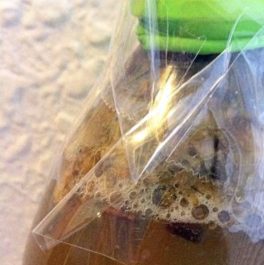From Trash to Gas: Biomass Energy

Summary
Have you ever dreamed of a world where you could take the scraps from last night's dinner and toss them into your car's fuel tank and make gas? Well, we're not quite in "Back to the Future" yet, but in this energy science fair project, you'll discover that food scraps, dead plants, sawdust, and other decaying organic matter, called biomass are a rich source of energy. You can get energy out of biomass by burning it, turning it into a liquid, or by turning it into a gas called biogas. You've probably burned biomass (like dead wood) before if you've ever built a campfire, and you've seen biogas being produced if you've ever watched cows happily munching on green grass. The cows eat a type of biomass (grass or hay) and turn it into the biogas, methane, in their digestive tracts. In this energy science fair project, you'll compare the amounts of biogas produced by different types of biomass.
This project idea was developed and written by Kristin Strong, Science Buddies. This science fair project idea was based on an 8th-grade, first-prize winning project by A. Osegueda in 2005.
Science Buddies Staff. "From Trash to Gas: Biomass Energy." Science Buddies, 30 Mar. 2022, https://www.sciencebuddies.org/science-fair-projects/project-ideas/Energy_p027/energy-power/from-trash-to-gas-biomass-energy.
This project idea was developed and written by Kristin Strong, Science Buddies. This science fair project idea was based on an 8th-grade, first-prize winning project by A. Osegueda in 2005.
Science Buddies Staff. "From Trash to Gas: Biomass Energy." Science Buddies, 30 Mar. 2022, https://www.sciencebuddies.org/science-fair-projects/project-ideas/Energy_p027/energy-power/from-trash-to-gas-biomass-energy.
Safety Precautions, Hazards, and Risk Assessment
This science fair project produces a small amount of a flammable gas, so it must be conducted in a well-ventilated area, away from any source of open flame or source of electrical sparks. Use caution and have an adult’s help when using the bleach, as it can cause chemical burns.
Teacher Recommendations or Piloting Data (if available)
N/A
Link to external
Creative Commons License

This work is licensed under a Creative Commons Attribution-NonCommercial-NoDerivatives 4.0 International License.
